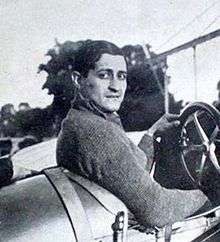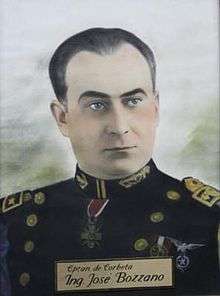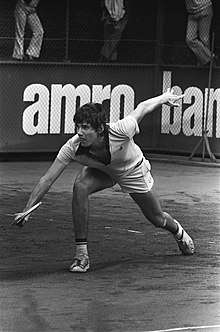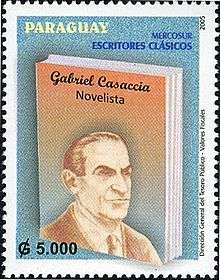Italians in Paraguay
| italo-paraguaiani | |||||
|---|---|---|---|---|---|
| |||||
| Total population | |||||
| around 40% of the total Paraguayan population is of full or partial Italian descent.[1] | |||||
| Regions with significant populations | |||||
| Asunción | |||||
| Languages | |||||
| Spanish, Italian, Guarani | |||||
| Religion | |||||
| Christianity (mostly Roman Catholic) | |||||
| Related ethnic groups | |||||
| Italians, Italian Argentines, Italian Brazilians, other Paraguayan people of European descent. | |||||
Italian Paraguayans are one of the most prominent ethnic minorities in Paraguay, consisting mainly of Italian residents who migrated to Paraguay or Paraguayan-born citizens of Italian descent. Italian immigration to Paraguay has been one of the largest migration flows this South American country has received.[2] Italians in Paraguay are the second-largest immigrant group in the country after the Spaniards (and nearly 40% of Paraguayans have at least an Italian ancestor, according to historian F. Constantini).
Migration history
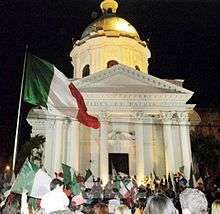
The number of Italian immigrants in Paraguay was by far the highlight of foreigners who settled in the country in the early postwar years after 1870. During the Paraguayan War, many Italian immigrants enlisted voluntarily rows of then President Mariscal Francisco Solano López.
In the period between 1882 and 1907, Italians were the largest group, exceeding 27% of total foreign arrivals in Paraguay.
After the unification of Italy in 1860, after Garibaldi's battles, it began the era of the great migrations that lasted until 1914. This yielded a very extensive migratory movement, between the years 1869-1913, more than 14 million Italians left their country.
However, most of the Italian immigrants came mainly from Lombardy (especially from Bergamo) and the rest of northern Italy, comprising individuals who arrived in Paraguay on their own and facing its risks.
The War of the Triple Alliance (1865–70), sometimes called the "Chaco War", was the bloodiest in Latin American history. The war was a disaster for Paraguay, which lost two-thirds of all its adult males. Paraguay's population fell from about 600,000 to about 250,000. For the next 50 years, Paraguay stagnated economically. The male population was replaced by an influx of immigrants from Italy, Spain, Germany, and Argentina. The census of 1899 showed a population of about 630,000 of whom nearly 100,000 were Indians. The foreign population in 1895 numbered 5000 Argentines, 2500 Italians, 1500 Spaniards, 1250 Germans, 800 French, 600 Brazilians, and 1000 Swiss, Austrians, English, and other nationalities.
The Italians were a relatively huge community of nearly 3000 persons at the beginning of the XX century, concentrated in the capital and the areas around it. This group of immigrants, largely made up of workers, architects, engineers and less by professionals in other fields, exercised great influence, especially on growth and urban development in Asunción and in the maintenance of the Paraguayan rail system. They created even small cities, like "Nuova Italia".
One of the most famous of them in the early XX century was Silvio Pettirossi (June 16, 1887 – October 17, 1916), who was a Paraguayan airplane pilot and aviation pioneer. In December 1914 he founded the Aeroclub de Paraguay and was named its president. Actually Asunción's Silvio Pettirossi International Airport, three soccer clubs, the "Airborne Brigade of the Paraguayan Air Force", a Paraguayan Air Force Base in Luque, an avenue in Asunción and the "Paraguayan Institute of Aviation History" are named after him.
Indeed some Presidents of Paraguay are Italo-paraguayans: José Patricio Guggiari; Andrés Rodríguez Pedotti (1988 - 1993), Juan Carlos Wasmosy Monti (1993 - 1998) and Luis Ángel González Macchi (1999-2003). Even some misses of Paraguay are descendants of Italians, like Fiorella Migliore.
According to prof. Fernando Constantini, 40% of the Paraguayans are descendants (in some blood percentage) from the Italian immigrants: the Italians were 15% of the male population on Paraguay in 1875, after the devastating Chaco war,[3] and now they are fully assimilated because of the many mixed marriages.
In 2012 there were 8.502 Italian citizens residents in Paraguay, according to the "Ministero degli Interni" of Rome.[4].
Famous Italian paraguaians
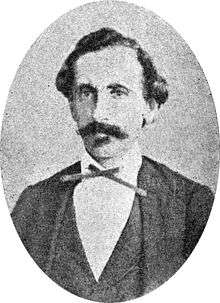
- José Patricio Guggiari, President of Paraguay (1928-1932)
- Andrea Pedotti, President of Paraguay (1988-1993)
- Juan W. Conti, President of Paraguay (1993-1998)
- Luis Gonzalez Macchi, President of Paraguay (1999-2003)
- Cirilo Antonio Rivarola, provisional President & President of Paraguay (1870-1871)
- Gabriel Casaccia, novelist considered the father of modern Paraguayan literature
- José Bozzano, military engineer and minister of economy
- Giacomo Bertoni, botanist and writer
- Fiorella Migliore, Miss "Italia nel Mondo" 2008
- Gladys Carmagnola, poet and writer
- Víctor Pecci, tennis champion
- Silvio Pettirossi, aviation pioneer
- Attila Sallustro, soccer champion
- Cayetano Ré, soccer champion
- Guido Boggiani, writer and explorer
- Maneco Galeano, musician
- Ignacio Alberto Pane, writer and journalist
